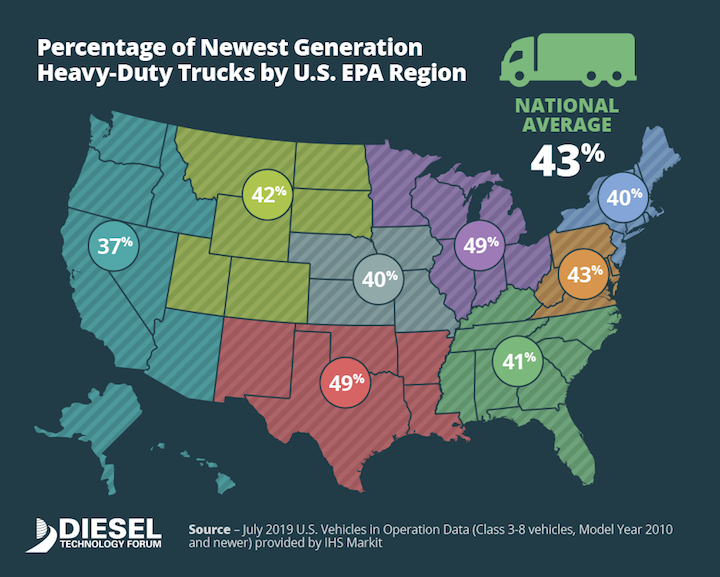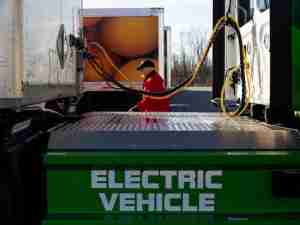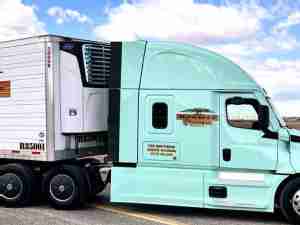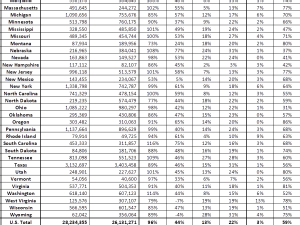In the states that comprise EPA Region 3, the newest, cleanest, near-zero-emissions diesel truck technologies now make up 43.4 percent of the diesel-powered commercial vehicles on U.S. roads – from box delivery trucks to 18-wheelers, according to the Diesel Technology Forum’s analysis of 2018-2019 U.S. vehicles in operation data (Class 3-8) provided by IHS Markit.

“As more of America’s commercial trucks rely on the newest, cleanest diesel technologies, greater air quality and fuel savings benefits are being realized by communities across the country,” said Allen Schaeffer, executive director of the Diesel Technology Forum. “This progress is particularly important in the Northeast states that make up EPA Region 3, as it is one of the heaviest trucking corridors in the nation. These new findings reinforce the importance of the new generation of diesel in delivering vital societal benefits today in the here-and-now. No technology is as vitally important to achieving current and future goals as advanced technology diesel engines.”
Across the Northeast, including Connecticut, Delaware, Maine, Maryland, Massachusetts, New Hampshire, New Jersey, New York, Rhode Island, and Vermont, the use of newest-generation diesel trucks has delivered substantial emissions reductions and fuel savings. Between 2011 and 2018, the use of the newest, cleanest diesel Class 3-8 trucks has saved 12.5 million tonnes of carbon dioxide (CO2) and eliminated 2 million tonnes of nitrogen oxides (NOx) in northeast states. By 2030, the increased use of the cleanest diesel technologies is expected to deliver an additional 118.5 million tonnes of CO2 reductions and eliminate an additional 5.6 million tonnes of NOx.
Beginning in 2011, all new heavy-duty trucks have been equipped with selective catalytic reduction (SCR) and particulate control technologies. These combine to achieve stringent new U.S. Environmental Protection Agency (EPA) emissions requirements for NOx emissions of no more than 0.20 grams per brake horsepower hour (g/BHP-hr). This is in addition to particulate matter (PM) emissions levels of no more than 0.01 g/BHP-hr.
National Analysis
Nationwide, the newest, cleanest, near-zero-emissions diesel truck technologies now make up 43 percent of the nearly 11 million diesel-powered commercial vehicles on U.S. roads, according to the Diesel Technology Forum’s analysis of 2018-2019 U.S. vehicles in operation data (Class 3-8) provided by IHS Markit.
Since 2010, these newest-generation diesel trucks have eliminated 126 million tonnes of CO2, 18 million tonnes of NOx, and saved 12.4 billion gallons of diesel and 296 million barrels of crude oil. Put into context, the emissions and fuel savings attributable to new-generation diesel engines in commercial trucks equates to making 26 million cars all-electric, achieving carbon sequestration in a forest roughly the size of Texas, or creating a 27,000-turbine wind farm on land four times the size of Washington, D.C.
Since 2007, technologies developed to meet near-zero standards for PM eliminated 1 million tonnes of PM, which is equivalent to eliminating the PM emissions from all U.S. cars for 33 years.
By 2030, thanks to the continued increase of newest-generation diesel-powered vehicles, these savings are projected to grow to 1.3 billion tonnes of CO2, 73 million tonnes of NOx, 4 million tonnes of PM, 130 billion gallons of diesel and 33.1 billion barrels of crude oil.
According to the same dataset from IHS Markit, a total of 17 states are at or above the national average for the percentage of clean diesel Class 3-8 commercial vehicles (All US: 43%), and 15 states are growing their clean diesel fleets faster than the national average (All US: 6.8%).









